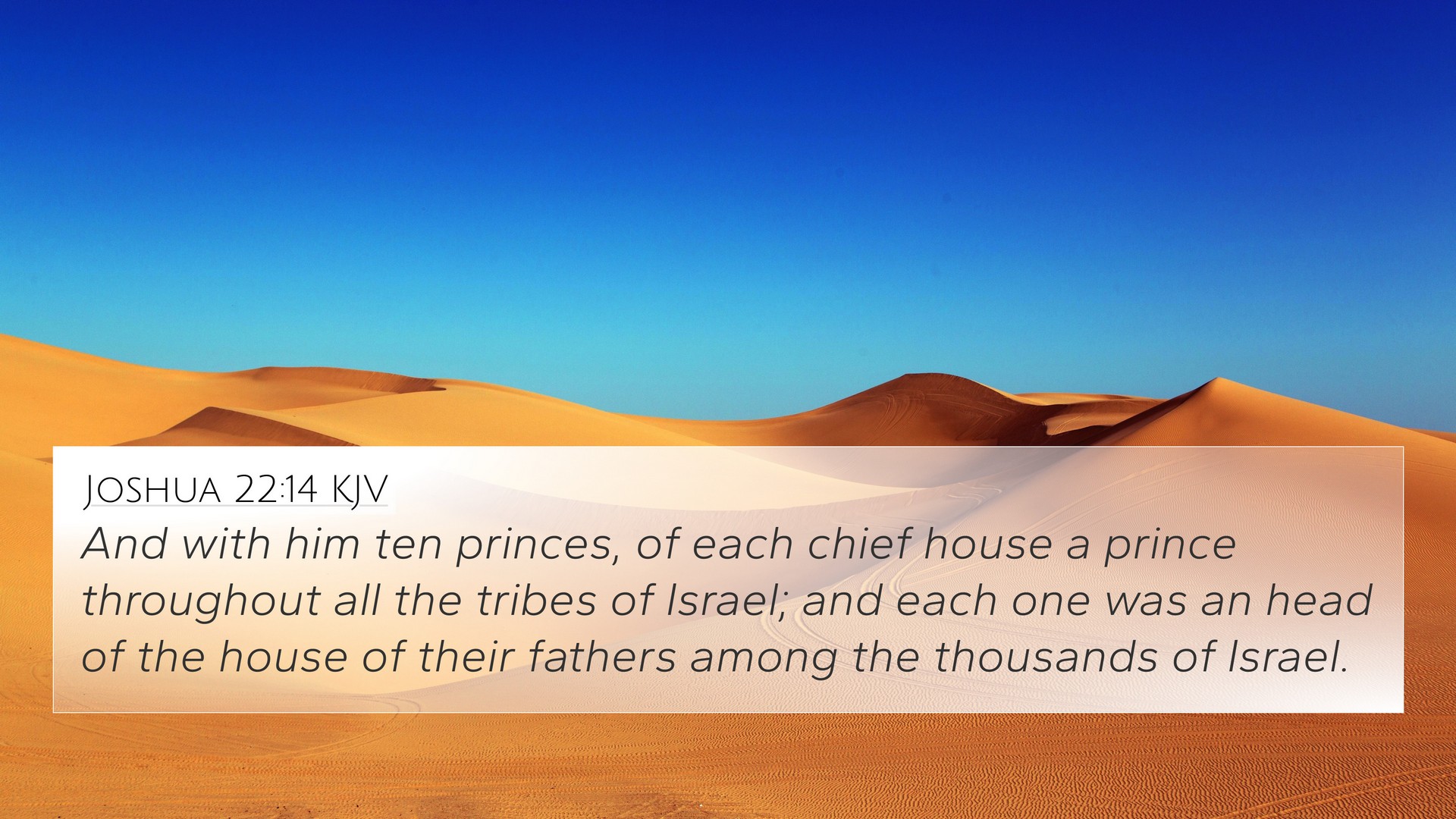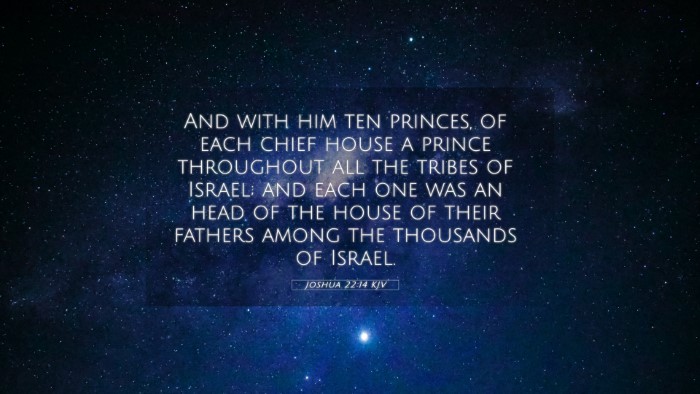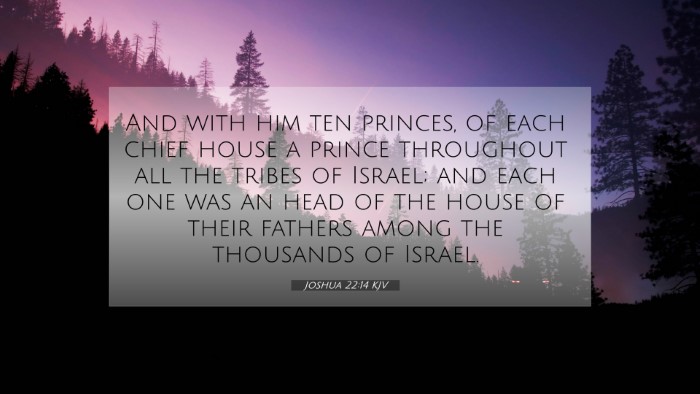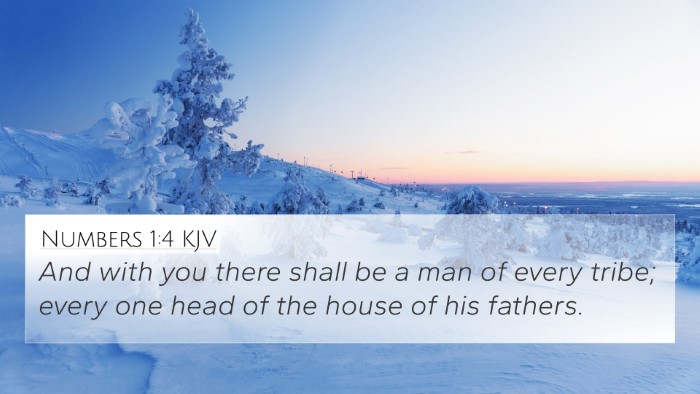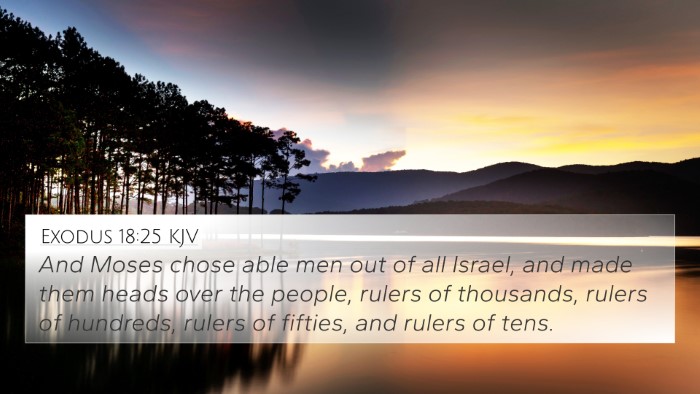Understanding Joshua 22:14
Joshua 22:14 states: "And ten princes of the ten tribes, the princes of the thousands of Israel, came unto the children of Reuben, and to the children of Gad, and to the half tribe of Manasseh, unto the land of Gilead." This verse depicts a significant moment in the narrative of Israel's history, highlighting both leadership and community dynamics. Below is a comprehensive analysis and interpretation of this verse combined from insights found in public domain commentaries by Matthew Henry, Albert Barnes, and Adam Clarke.
Contextual Overview
The Israelites had just conquered Canaan and were dividing the land among the tribes. The tribes of Reuben, Gad, and the half-tribe of Manasseh were to settle east of the Jordan River. The gathering of the princes signifies a high-stakes moment regarding unity and potential conflict within the nation of Israel.
Key Themes in Joshua 22:14
- Leadership: The gathering of these ten princes illustrates the importance of leadership in addressing concerns among the tribes.
- Dialogue and Communication: This verse signifies the necessity of open conversations and understanding among the tribes, highlighting how issues are best resolved through discussion.
- Unity and Division: The inquiry into the state of the eastern tribes highlights the tension between maintaining unity and addressing the fears of division.
- Faithfulness to God’s Commands: This moment is pivotal in ensuring that all tribes remain committed to the covenant made with God.
Biblical Cross-References
This verse can be understood better by linking it with various other Scriptures, which enrich its context and meaning:
- Numbers 32:1-5: This passage records the initial request of the Reubenites and Gadites to settle on the eastern side of the Jordan.
- Deuteronomy 3:12-16: Further details the allocation of land to these tribes and the rationale behind it.
- Joshua 1:12-15: Reaffirms the commitment of these tribes to assist in the conquest of Canaan, ensuring their loyalty.
- James 5:16: Illustrates the importance of confessing and addressing conflicts within communities, reflecting the necessity of reconciliation highlighted in Joshua 22:14.
- Matthew 18:15-17: Jesus instructs on resolving disputes in a spirit of unity, exemplifying thoughtful engagement found in this Old Testament narrative.
- 1 Timothy 6:12: Calls believers to fight the good fight of faith, paralleling the Israelites’ battle for unity and commitment to God's covenant.
- Romans 15:5-7: Encourages unity among believers, akin to the unifying message in Joshua 22.
Comparative Analysis
When we consider the inter-Biblical dialogue surrounding this passage, we observe a recurring theme of community and the role of leaders. Notably:
- In Romans 12:4-5, Paul emphasizes the interconnectedness of the body of Christ, reflecting the tribes' unity.
- Acts 15:1-31 shows how early church leaders communicated effectively to resolve doctrinal disputes, mirroring the principles of unity seen in Joshua's gathering.
- This moment is foundational for understanding the later challenges faced by the tribes when divisive sentiments emerge, as shown in Judges 8:1, where the behavior of different Israelite groups is questioned.
Interpretative Insights from Commentaries
Each commentary offers valuable insights into Joshua 22:14:
- Matthew Henry: Highlights the significance of leadership and the responsibilities that come with guiding a community towards harmony.
- Albert Barnes: Points out the intention behind the princes' gathering as a way to ensure that all tribes adhere to the promises made to God, showcasing the importance of accountability.
- Adam Clarke: Offers a deeper exploration of the geographical and cultural implications of the tribes settling in Gilead, emphasizing their faith and unity.
Conclusion
Joshua 22:14 encapsulates essential themes of leadership, communication, unity, and commitment, both historically for the Israelites and spiritually as lessons for contemporary believers. By cross-referencing this verse with others, we can gain a more comprehensive understanding of its implications and applications within the broader biblical narrative.
Utilizing tools for Bible cross-referencing and engaging in comparative Bible verse analysis can help readers grasp the intricate connections within scripture and apply these insights to everyday faith journeys.
